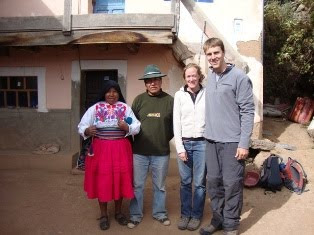- At 12,500 feet above sea level, it is the highest navigable body of water in the world (this meant that we were both feeling the affects of altitude sickness – shortness of breath, sluggishness, and dizziness. Altitude sickness apparently occurs because there is a lot less oxygen in the air.)
- Lago Titicaca is the home to indigenous people who live 100% of their time on floating islands of reeds!
- It is the border between Bolivia and Peru.
- A metal ship built by the British was carried piece by piece all the way up to the lake and then put back together once there. To my knowledge there weren’t any major naval battles, but not it’s retired and I believe is a restaurant.
The next morning we started our organized tour of the Lake Titicaca. We hadn’t done a lot of organized tours up to this point so we were a little leery of the tourist route. As it turned out the 2 day, 1 night trip was fabulous!
Floating Islands: The first stop on our tour was the floating islands made of reeds. First of all you may ask (as I did) – what do you mean floating islands? Do you mean a little boat or something? NO. Whole families and villages live on floating, man-made islands, and they’ve been doing this for thousands of years in much the same way (except for the show case islands, where we snuck around and found a solar panel and satellite … he,he).
Here’s a photo of a boat and the islands in the foreground and back-ground. The video below will show you even better what the islands are like.

Floating Islands - Lake Titicaca from Chad Carson on Vimeo.
Apparently the islanders use reeds that grow abundantly all over the lake. They tether together groups of these reeds and stack them on top of each other – until they’re about 6 -8 feet thick. Interestingly the reeds can also be eaten. You peel the reed like a banana, and the consistency is sort of like soft celery or rhubarb. Chad gives it a try below:

We were encouraged to try on some of their traditional clothes, which we had fun doing (Kari said I look good in multi-neon-colors):

Isolated Island of Amantani:
This was probably our favorite part of the tour. We got to stay on an island called Amantani with a native family, and for the afternoon and evening we experienced life like them.

First we had a delicious meal of homemade cheese and a variety of local potatoes (Peru has hundreds of varieties, by the way):

After our lunch, we took a hike up to the top of the island – where there are two peaks – each with old temples that are still used to this day by the locals. The first, more popular temple with the tourists – was for the Sun God – Pacha Tata. The Sun God was the primary god for the Incas, and was the most powerful and heavenly of the gods. This temple is on top of hill on right of photo:

Also important to the Incas and most traditional cultures was Pacha Mama or mother earth, the provider and body of everything here on earth. This temple was on the other island peak (and a little higher, interestingly enough), it was a little less crowded, and it just had a mystique about it. So we decided to visit there and watch the sunset.
There aren’t many words to describe these kinds of beautiful, sublime experiences, but we’ll try to let you get a taste in a few photos:
 Sunset over Lago Titicaca
Sunset over Lago Titicaca Sunset over Pacha Mama Temple
Sunset over Pacha Mama Temple
 Thinking Woman Kari
Thinking Woman Kari
Dancing Time! When we got back from our hike at sunset, our family had another tasty dinner ready for us – with soup and more potatoes (I got the feeling you eat a lot of potatoes here). We sat at the table with the father of the host family – Elias Mamani Pacompia.
We exchanged stories of our lives (Kari was very proud of me, because I was the primary translator between the family and the British couple, and I even got most of it right!) Elias told us that they worked hard in their fields and had enough to eat each year, but he had 3 children in college. The farming provided food but no money, so the tourism and periodic working trips on the mainland were necessary to help provide a better life for his children. Kari and I were inspired by this humble, hard working family.
After dinner our host mother dressed us both up in traditional clothes to get ready for the fiesta!

At the fiesta there was traditional music – composed of several flutes, a drum, and a small guitar like a ukulele. The rhythms and sounds were one of a kind, and we danced four a couple of hours (with much needed breathers in between!)
At the end of this trip we both agreed that we had experienced something special and unforgettable.


No comments:
Post a Comment